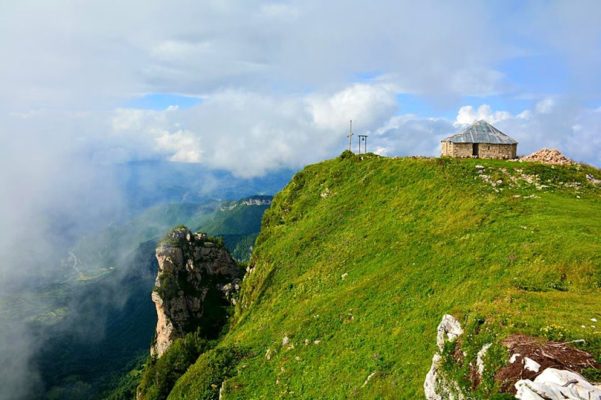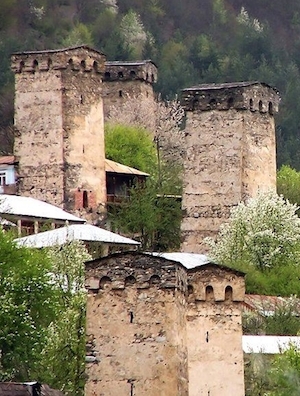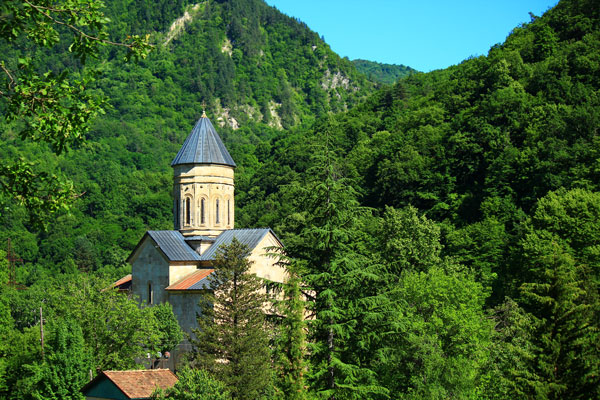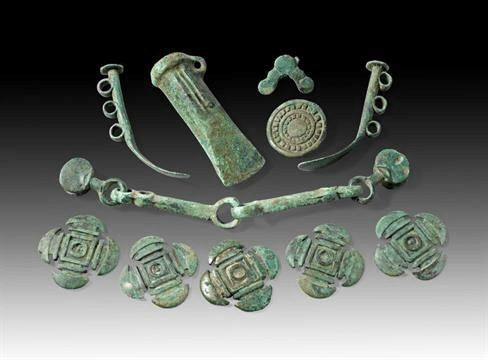Walking in the Caucasus
A Svaneti Highlands Experience in West Georgia
August 24th - Sept. 5th, 2024
August 23rd - Sept. 4th, 2025
Registration: OPEN (Max 15 participants)
This tour is designed for those that enjoy walking in natural beauty, but want to conclude a day of walking with a comfortable shower and cozy bed. Come walking in the Caucasus with us! We combine guided walks in the mountains (varying levels of difficulty) with cultural visits with local families and site visits to unique medieval churches and fortresses. This is not a luxury trip, but we make sure everyone is very comfortable. We’ll be walking. We’ll be visiting churches. We’ll hear traditional music, and sample plenty of excellent local cuisine and wines/beers. The walks a couple of 6-hour longer walks that climb switchback trails or follow trails along glacial rivers to their source with elevation gain of 2000 feet. There are no hikes above 8700 feet altitude. We also have several shorter 3-4 walks. The hikes do not follow dangerous cliff edges. The vistas, clean air, and unfettered access to local agrarian cultural life make the drives worth it.
Details:
- Arrive-Depart Tbilisi (airport designation TBS)
- 12 day overland travel itinerary (13 nights inclusive)
- Visas: US or EU passport holders do not need a Georgian visa. For other nationalities, check the country listings
- Maximum 15 guests (only a deposit secures a place on tour)
Tour Leaders:
- Dato Beridze
- Invited specialists and guest musicians
Accommodation:
- Best available boutique hotels and guesthouses
Brochure:
- Contact us for the invitational tour brochure and registration form. Email: admin@johngrahamtours.com
Registration:
- Submit registration form (sent at your request)
- Send deposit of $1000 to secure your place (details in registration form)
Fees 2024:
- $3450 Register by August 24th, 2023
- $3700 Register after August 24th, 2023
- $460 Single supplement
- Silver: 5% discount
Payment Methods:
- Bank transfer (preferred)
- Personal check to Vermont address
- Credit card via Paypal (3% Paypal charge applies)
Post-Tour Options
- Organize a private tour to Armenia!
Included:
- Accommodation in high quality best-available boutique hotels and guesthouses.
- All ground transportation including airport transfers
- All meals with wine/beer as noted in itinerary
- All entrances
- Guides
- Entertainment (traditional singers, a ballet or opera if performance dates match our itinerary)
- Water on the bus, snacks (we pamper our guests!)
Not Included:
- Airfare
- Tips for primary guides and driver
- Personal services (laundry)
- Food-drink not specified in itinerary
Mobility-Fitness:
- Standard: 7/10 on the mobility scale (10 being the most demanding).
- This tour is designed around hikes in the mountains. General fitness required. Must be able to walk 6-8 miles on uneven rocky terrain. If walks are too demanding there is always an option to skip the walk.
- Primary transportation in minibus. We take rest stops at least every two hours on the longer driving days across country.
Special Notes:
- Unique itinerary
- Best available hotels and guesthouses
- Lots of arts and music on this itinerary
- Plenty of walks, this itinerary is based on walking every day, especially the six days in the highlands.
- We eat and drink very well, varied diet, always plenty of vegetarian options.
Weather:
- We will expect late summer weather, which is generally the driest season in the highlands. Prepare for temperatures between 65-85F, likely that we will have at least one thunderstorm day. In the lowlands, it can still be hot (80-90F). We'll expect many gorgeous days to be outdoors!
Walk in the Caucasus Videos!
Travel Program...
We begin and end the tour in Tbilisi, the capital of Georgia (airport designation TBS) and a beautiful city that featured prominently on trade routes from Asia to Europe. Walking in the Caucasus is a pleasure! This is a tour of sites, sounds, and tastes to thrill even the most seasoned travelers. The focus of this unique itinerary will be the ancient, medieval, and modern architectural and cultural monuments in West Georgia - the region of ancient Colchis on the Black Sea coast, and the mysterious gold-producing highlands of Svaneti, where the medieval towers dotting the hillsides make each village looks like a defensive fortress.
Our first meeting will be a champagne toast at the hotel followed by a banquet of fresh local cuisine with Georgian wine. On our first day in the city, we'll visit the acclaimed national museums, then take a walking tour of the synagogue, mosque, Persian baths, churches, the botanical garden, and carpet shops of the Old Town. On the way from Tbilisi to Svaneti, we will take advantage of stopping over in the city of Kutaisi to visit its fantastic medieval Christian cathedral sites, synagogue, spice market, and local natural wonders such as the Prometheus cave complex and the Martvili canyon and waterfall. The jewel of the Caucasus is in the highland region of Svaneti, where we will explore the mountain tops and valleys by foot, taking 4x4 jeeps to the trailheads. Our dedicated team takes care to locate and vet every trail, hotel, restaurant, and transport for the best quality.
Historical and Cultural Overview...
Ancient seafarers plying the eastern shores of the Black Sea encountered misty and jungle-covered precipices plunging into the coastal beachheads. These were the lands of Colchis, an ancient kingdom that historians date to at least 1300 BC. Strabo, a Greek historian himself from the Black Sea region, wrote about both Colchis and the Soanes, one of the first references to the allied highland tribes of Svaneti. According to Greek mythology, Colchis was a fabulously wealthy land situated on the periphery of the Greek world. Here, in the sacred grove of the war god Ares, King Aeëtes hung the Golden Fleece until it was seized by the Greek heroes, Jason and the Argonauts. Jason escapes with the fleece, and the princess Medea, only to be pursued by the Colchians to the fortress of Apsaros (Gonio). The Romans called Colchis the kingdom of Lazica-Egrisi, and we visit two sites from this period: Gonio fortress on the coast, and the Archeopolis fortress inland. A unique language is spoken in former Colchis, Megrelian, which features a unique culture and folksong culture. Traveling up a narrow gorge from the plains of ancient Colchis, the hidden valleys of Svaneti eventually reveal themselves among the snow-capped peaks of the Great Caucasus range. In the 19th century, famous alpinist-explorers such as David Freshfield and Vittorio Sella recorded their travels through the area. Speaking an ancient language only distantly related to the Georgian and Megrelian languages of the lowlanders, the Svans are a fierce and proud people who have preserved aspects of their ancient rituals and traditions to the modern day. Certainly their three-voiced polyphony is unique: it preserves an ancient tuning system that is at once vigorous, intoxicating, and ear-ringing. Iconic defensive towers from the 10-11th centuries lend a feeling that these villages have been frozen in time. But Mestia, the regional center, has been renovated to accommodate growing tourist demand, and now features modern hotel facilities and a ski resort. The neighboring highland region of Racha is described as the jewel of the Caucasus. Our main cultural destination there will be 12th century Nikortsminda cathedral which has the finest exterior stone-carving and interior wall-paintings in all of Georgia. Further into the mountains, we find a synagogue, one reminder of the pre-emigrant Jewish community that thrived in this highland region until their voluntary emigration in the late 1970s.
Christianity in Georgia...
Georgia was one of the first states to convert to Christianity in the early fourth century, and it became an important socio-religious factor in the identity of Georgia as it struggled to survive against constantly invading empires. Many local legends describe the preaching of Apostles Andrew and Matias in West Georgia in the first century; Matias is said to be buried in the fortress of Gonio, and on the site where Apostle Andrew cut down a giant oak tree to prevent human sacrificies at Martvili, a seventh century limestone monastery marks the site. Certainly by the fourth century, Christianity had become stronger as a bishop from Lazica-Egrisi attended the First Council of Nicaea in 325 AD. Monasticism became an important expression of Christianity, with the monarchy and local aristocracy supporting the construction of fantastic cathedrals in the city centers and ornately carved monasteries in remote mountain valleys. Georgian communities were also active abroad in monasteries in Greece, Antioch, Jerusalem, and Egypt. Christianity took hold in the highland region of Svaneti in the tenth century, when more than 200 chapels appeared in every village and a unique wall-painting tradition flourished. In addition to the early Christian influence, Georgians are culturally closest to the ancient Mediterranean societies with their joy of song and dance, cultivation of the grape, and strong clan affiliation. Over the centuries, Persian, Turkish, and Arab words, cuisine, and values have also entered the Georgian cultural consciousness.
Request the full brochure! Email: admin@johngrahamtours.com
Tour Locations:
Tbilisi
+ Tbilisi, capital city of Georgia, founded in the 5th century by King Vakhtang Gorgasali. A center of trade and conflict for centuries, Tbilisi has been sacked forty times by various invaders but survives today as the modern hub of the South Caucasus. Nevertheless, the downtown area is full of winding cobblestone streets, small shops and restaurants, as well as the churches, synagogues, and mosques that celebrate the diversity of this unique country. As we tour monasteries in the ancient capital region, a comfortable downtown Tbilisi hotel will serve as our home-base, affording a chance to sample the best of Tbilisi's dining and evening entertainment, and visit the wealth of museums, spas, and cultural delights in the "Old Town."
Mtkvari River Valley
+ Starting in Tbilisi (named for the hot springs along the river), we journey upstream to the ancient capital Mtskheta. Dominated by the 11th century Cathedral of the "Living Cross," Mtskheta was once the thriving trade capital of East Georgia but is now a quaint little hamlet at the confluence of Mtkvari and Aragvi rivers. The Romans reached Mtskheta in 65 AD, as evidenced by the remains of a bridge left behind, and in the early Christian era, St. Nino the Enlightener worked miracles, converting the Iberian King Mirian and his queen Nana to Christianity in 337 AD. Further up the Mtkvari River, we visit the Ateni Sioni Church (7th c.), before leaving the valley to venture past the Surami Fortress and over the pass into Imereti-Samegrelo in West Georgia.
Imereti - Samegrelo
+ Historic Georgia was divided by the Surami mountain range into two kingdoms: Iberia in the East with its capital in Tbilisi, and Colchis in the West with its capital in Kutaisi. This historic region has also been variously called Egrisi, Lazika, and today is called Samegrelo. According to legend, Jason and the Argonauts sailed to the ends of the known (Greek) world, Colchis, to steal the princess of the land and its wealth of gold. Indeed, exquisite jewelry and weaponry was created by a cadre of artisans given access to the valuable mines in the high Caucasus, some of which is visible in museums today. Our visit will include two nights in Kutaisi and two nights in Batumi, the coastal port city once inhabited by Roman traders. Sites include the ancient Georgian-Greek fortress city of Archaeopolis, the Roman fortress at Gonio (2nd c.), and the Kutaisi National Museum. From the Christian era we will visit the Martvili and Ubisa monasteries (7th-9th c.), the Bagrat cathedral (10th c.), the Gelati academy and monastery (12th c.), and the cathedral of Khobi.
Svaneti - Racha
+ Traveling up a narrow gorge from the plains of ancient Colchis, the hidden valleys of Svaneti eventually reveal themselves among the snow-capped peaks of the Great Caucasus range. In the 19th century, famous alpinist-explorers such as David Freshfield and Vittorio Sella recorded their travels through the area. Speaking an ancient language only distantly related to the Georgian of the lowlanders, the Svans are a fierce and proud people who have preserved aspects of their ancient rituals and traditions to the modern day. Certainly their three-voiced polyphony is intoxicating, preserving a unique tuning system without parallel in the world. Christianity spread to the region in the tenth century, where it thrived alongside animist traditions that remain in syncretism today. From this era, several chapels reveal a unique school of fresco painting, while the newly renovated National Museum boasts gold and silver icons from the 10th-14th centuries, four illuminated gospels from the ninth and tenth centuries, as well as priceless objects from many regions of Georgia spirited up to the mountains in times of war and protected there ever since. In each Svan village, defensive towers (10-11th centuries) protected each family from attack. These iconic towers dominate the hamlets, which seem frozen in time. But the capital city has been renovated to accommodate growing tourist demand, and now features modern hotel facilities and a ski resort. On our trip, we will visit several museums in towers, and stay in Mestia and Ushguli, two of the centers featuring some of the most historic towers in Svaneti.
Request the full brochure! Email: admin@johngrahamtours.com












